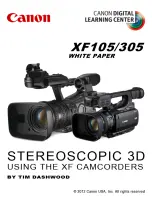
GENLOCK SYNC:
Genlock is very important in S3D production because it allows the shutters to sync to each other to
prevent temporal disparity and it also syncs the output video signals together so that stereoscopic
muxer boxes can combine the signals.
If you are shooting in 25p, 50i, 30p, 60p or 60i modes then you can easily sync from one camera to
the other by using the included component cable and an RCA to BNC adapter. Both the left and right
cameras must be in the exact same recording mode. Just plug the component cable into the
component terminal of the “master” camera and attach the luminance (green) end to the RCA to BNC
adapter and then connect to the GENLOCK BNC input on the “slave” camera. The slave camera should
stabilize its synchronization after about 10 seconds. You may see a disturbance on the screen while
the synchronization is being locked. If you are using
XF105 cameras you will need to go into the “Other
Functions” menu and then “Genlock/TC Term” menu to set
the input to GENLOCK input signal.
If you intend to shoot 24P then signals from a tri-level sync
generator (like AJA’s Gen-10) will need to be input into the
GENLOCK port on both cameras. This is required so that
the pulldown patterns on the two cameras sync perfectly.
With either method you should ensure that the horizontal
and vertical phase in the genlock menu of the slave
camera is set to 0. There should be no need to adjust the
phase.
OTHER MENU SETTINGS
Synchronized menu/exposure settings, record trigger and zooms using IR remote
It is easiest to set your desired gamma, matrix, and other internal settings on one camera and then
save the scene
fi
le to a SD card and load on the other camera. This will ensure that both cameras
have the same basic settings. You can save your settings to the SD card by selecting the OTHER
FUNCTIONS menus, TRANSFER MENU and then SAVE TO. Select OK and press SET. Then move the SD
card to the other camera and select OTHER FUNCTIONS, TRANSFER MENU and LOAD FROM. Select
OK and press SET.
XF300/305 Whitepaper
Stereoscopic 3D
Tim Dashwood
11
Tri-Level Sync Generator connected
to both cameras’ genlock terminals
Summary of Contents for XF105
Page 1: ......

















